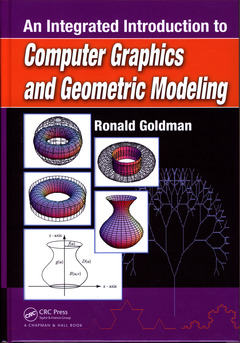An Integrated Introduction to Computer Graphics and Geometric Modeling Chapman & Hall/CRC Computer Graphics, Geometric Modeling, and Animation Series
Auteur : Goldman Ronald

Taking a novel, more appealing approach than current texts, An Integrated Introduction to Computer Graphics and Geometric Modeling focuses on graphics, modeling, and mathematical methods, including ray tracing, polygon shading, radiosity, fractals, freeform curves and surfaces, vector methods, and transformation techniques. The author begins with fractals, rather than the typical line-drawing algorithms found in many standard texts. He also brings the turtle back from obscurity to introduce several major concepts in computer graphics.
Supplying the mathematical foundations, the book covers linear algebra topics, such as vector geometry and algebra, affine and projective spaces, affine maps, projective transformations, matrices, and quaternions. The main graphics areas explored include reflection and refraction, recursive ray tracing, radiosity, illumination models, polygon shading, and hidden surface procedures. The book also discusses geometric modeling, including planes, polygons, spheres, quadrics, algebraic and parametric curves and surfaces, constructive solid geometry, boundary files, octrees, interpolation, approximation, Bezier and B-spline methods, fractal algorithms, and subdivision techniques.
Making the material accessible and relevant for years to come, the text avoids descriptions of current graphics hardware and special programming languages. Instead, it presents graphics algorithms based on well-established physical models of light and cogent mathematical methods.
Two-Dimensional Computer Graphics: From Common Curves to Intricate Fractals. Mathematical Methods for Three-Dimensional Computer Graphics. Three-Dimensional Computer Graphics: Realistic Rendering. Geometric Modeling: Freedom Curves and Surfaces. Further Readings. Index.
Ron Goldman is a professor of computer science at Rice University, Houston, Texas. Dr. Goldman’s current research interests encompass the mathematical representation, manipulation, and analysis of shape using computers.
Date de parution : 09-2009
17.8x25.4 cm
Date de parution : 10-2019
17.8x25.4 cm
Thèmes d’An Integrated Introduction to Computer Graphics and... :
Mots-clés :
Iterated Function Systems; Turtle Programs; fractal curves; Sierpinski Gasket; turtle graphics; De Casteljau Algorithm; affine transformations; Control Polygon; b-spline; Koch Curve; three-dimensional computer graphics; De Casteljau; Control Points; Control Polyhedron; Bump Fractal; P0 P0 P1 P1; Ray Trace; Convex Hull; Bezier Patches; Polynomial Segment; Conformal Transformations; Ray Casting; Fractal Curve; Nonuniform Scaling; Perspective Projection; Left Lateral Edge; Tensor Product; P0 P0; Ray Casting Algorithms; Scan Line Algorithm



